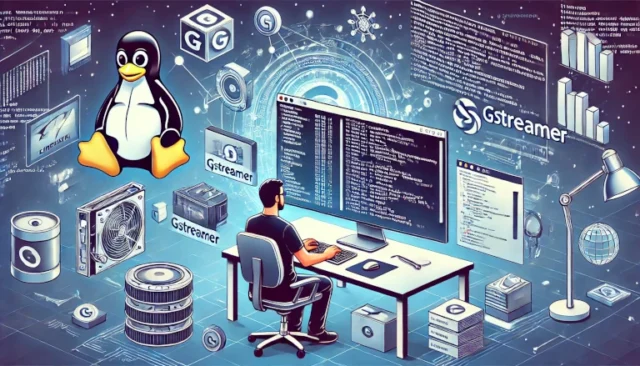GStreamer is a powerful open-source multimedia framework used for building robust media applications on Linux. Whether you’re developing a video player, audio processing software, or real-time streaming application, GStreamer provides an extensive set of plugins to handle various multimedia tasks. If you’re looking to install GStreamer on Linux for application development, this guide covers everything from installation, setup, common issues, and troubleshooting tips.
What is GStreamer?
🔹 GStreamer is a media framework that allows developers to create audio and video applications using a modular pipeline-based architecture.
🔹 It supports various media formats, codecs, and streaming protocols, making it a popular choice for multimedia processing.
🔹 The plugin-based design makes it highly flexible and customizable for different application requirements.
Developers use GStreamer in Linux to build custom media players, video editors, streaming solutions, and real-time multimedia applications.
How to Install GStreamer on Linux?
Installing GStreamer on Linux is straightforward and depends on your distribution. The installation includes core libraries, plugins, and development tools.
For Ubuntu/Debian-based systems, install GStreamer with:
sudo apt update && sudo apt install gstreamer1.0-tools gstreamer1.0-plugins-base gstreamer1.0-plugins-good gstreamer1.0-plugins-bad gstreamer1.0-plugins-ugly gstreamer1.0-libav
For Fedora-based systems, use:
sudo dnf install gstreamer1 gstreamer1-plugins-base gstreamer1-plugins-good gstreamer1-plugins-bad gstreamer1-plugins-ugly gstreamer1-libav
For Arch Linux, install via pacman:
sudo pacman -S gstreamer gst-plugins-base gst-plugins-good gst-plugins-bad gst-plugins-ugly gst-libav
Once installed, verify by running:
gst-inspect-1.0 --version
If GStreamer is installed correctly, it will display the version number.
Setting Up GStreamer for Application Development
To develop applications using GStreamer, install the development libraries.
On Ubuntu/Debian, use:
sudo apt install libgstreamer1.0-dev libgstreamer-plugins-base1.0-dev
On Fedora, use:
sudo dnf install gstreamer1-devel gstreamer1-plugins-base-devel
This ensures that the required GStreamer headers and libraries are available for compiling applications.
To compile a basic GStreamer application, create a simple C program:
#include <gst/gst.h>
int main(int argc, char *argv[]) {
gst_init(&argc, &argv);
g_print("GStreamer Initialized!\n");
return 0;
}
Compile the program using:
gcc -o test_app test_app.c `pkg-config --cflags --libs gstreamer-1.0`
This generates an executable that initializes GStreamer and prints a confirmation message.
Common Issues and Troubleshooting
1. GStreamer Plugins Not Found
✔ Ensure all necessary plugins are installed using:
sudo apt install gstreamer1.0-plugins-{base,good,bad,ugly} gstreamer1.0-libav
✔ Verify available plugins with:
gst-inspect-1.0 | grep plugin
2. Application Fails to Link Against GStreamer
✔ Check if pkg-config correctly detects GStreamer:
pkg-config --modversion gstreamer-1.0
✔ If not found, reinstall development packages.
3. No Video Playback or No Sound Output
✔ Run a test pipeline to check if GStreamer is working:
gst-launch-1.0 videotestsrc ! autovideosink
✔ If the video does not display, check dependencies:
sudo apt install gstreamer1.0-gl gstreamer1.0-alsa
4. Pipeline Execution Errors
✔ Debug pipelines using:
gst-launch-1.0 --gst-debug-level=3 playbin uri=file:///path/to/video.mp4
✔ If errors persist, reinstall GStreamer components.
Why Use GStreamer for Linux Application Development?
🔹 Cross-Platform – Works on Linux, macOS, Windows, and embedded devices.
🔹 Extensive Codec Support – Handles MP4, MKV, MP3, AAC, FLAC, H.264, VP8, and more.
🔹 Real-Time Streaming – Supports RTSP, WebRTC, and adaptive streaming.
🔹 Highly Modular – Allows developers to create custom multimedia applications.
🔹 Open-Source and Actively Maintained – Ideal for commercial and research-based projects.
By leveraging GStreamer for Linux development, developers can build powerful media applications with flexibility and scalability.
Installing GStreamer on Linux for application development is a straightforward process that unlocks powerful multimedia capabilities. Whether you’re working on video processing, live streaming, or interactive media applications, GStreamer provides a solid foundation. By following the installation, setup, and troubleshooting steps outlined in this guide, you can start developing with GStreamer efficiently.
Start using GStreamer today to create next-generation Linux media applications!
